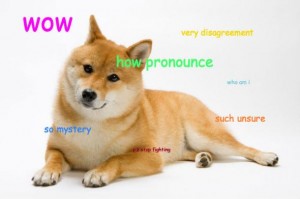Such blog. Much Shenandoah. Wow.
If you are hip on the lingo you have probably encountered such syntax. If not, then I’d like to introduce you to Shibe Doge, the hottest meme in the ether. Memes, for the uninformed, are a mode of cultural imitation. In previous iterations, memes could be as simple as a hand gesture used in a friend-group. Modern usage of the term implies a certain level of technological involvement, i.e., the Internet meme. Imperative to the “memetic” genre, imitation functions as the most prevalent mode of transmission. A humorous photo or turn of phrase does not achieve honorary meme status until it can be applied to various situations in everyday life. Yet it sometimes seems like the current meme of choice is more like a soup du jour rather than a hearty entree. But that doesn’t mean we can’t enjoy it as it is placed in front of us.
Most memes find their beginnings on the sad corner of the Internet known as 4chan, where people are enabled by anonymity to post on various message boards and engage in discussion that is otherwise considered taboo. 4chan is where the rogue 4chan user finds a popular story or image and adopts it before posting it to their account on Reddit, another social media site. These websites can be considered cultural filters wherein memes have their origin, but are inspected for quality assurance purposes. At last an up-and-coming meme will find its way onto Tumblr where it will gain fame among the populace of adolescents who know their way around other social media forms such as Twitter, Facebook, and even Imgur. Once a meme reaches success on Tumblr, it is only a matter of time before the phrasing or the general idea of the meme becomes mainstream. This trickle-down process can last anywhere from a day to several months. Only when the meme achieves vocal imitation does it lose its momentum.
Memes feed the desire for instant gratification among the technologically obsessed generations currently rising to power. In the current day and age, we experience growth through our various obsessions with social media and by finding new and improved ways to communicate. This modern obsession makes me wonder about how we connect with literature. Perhaps memes are comparable to a past focus on poetry. For example, at an eighteenth-century party, whipping out Byron’s latest couplet would make you the most popular person in the room. In the same way, while reciting memes may be considered gauche in an everyday setting, we are expected to engage with them on an intellectual level. If a person lacks knowledge of the most recently popular meme, they are judged by others as nearly illiterate Luddites.
The Internet is almost a living entity. It shifts and changes every hour, every second, and to be a functioning member of society we are expected to keep up on the latest trending topics. Memes have surfaced as an easy way to participate in the quasi-literature of the Google age and this generation’s quest for self-discovery. It’s up to you to decide whether you are a Socially Awkward Penguin, Corporate Cat or whether you just suffer from First World Problems. Any way you go, memes will follow (and probably apply).


